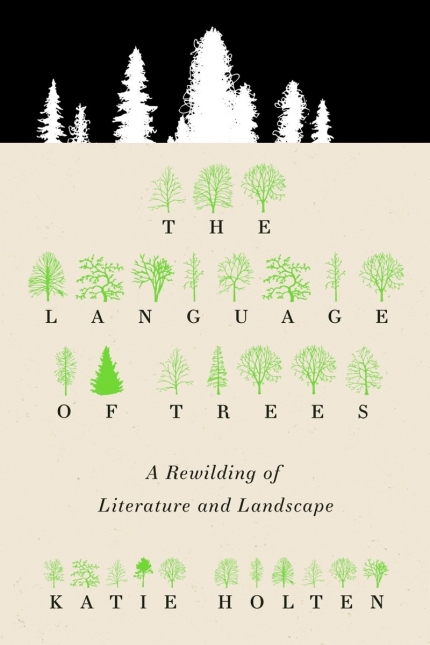The Language of Trees: A Rewilding of Literature and Landscape
- By Katie Holten
- Tin House
- 320 pp.
- Reviewed by Samantha Neugebauer
- April 13, 2023
An exquisite ode to all things arboreal.

One of my earliest memories is of driving down Roosevelt Boulevard with my grandmother. This was in Northeast Philadelphia in the early ‘90s, a time when that road was an ocean of colossal oaks. It was autumn. The light was golden. My grandma steered her boat-like Chrysler New Yorker carefully with both hands, and by some trick of the light, the enormous oak-leaf shadows raced through the car, painting themselves on the dash, our arms, pants, and her honey-brown leather seats.
I can still see those shadows fleeing from us, like shooting stars, over our heads and out the back window. How was it trees could be so magisterial yet so playful?
When we’re small, people say, things seem bigger than they are. That’s normally true, but these trees really were giants. Even the adults said so. Or maybe trees just turn grownups into kids again. Young or old, we all have our tree stories. There are birches we’ve loved and lost. Poplars we look forward to seeing like they’re old friends. We walk down one street instead of another because of its weeping willows. We choose the smaller apartment with a Japanese maple out front over the larger unit without one. We survey stark city blocks or box-store stretches and think, “This would be so much nicer with some trees.”
For all these reasons, Katie Holten’s The Language of Trees (an expansion of her 2015 book, About Trees) is a joy. Holten, an Irish artist and environmental activist, has invented “a new ABC” for us, a tree alphabet, by taking each of the 26 letters of the Latin alphabet and creating a corresponding arboreal illustration. S, for example, is a sycamore, H a horse chestnut, P a pine, etc. Her tree glyphs are careful, calming little portraits; they come in uppercase and lowercase. On the page, they appear dark green, almost black. None are larger than my thumb.
The Language of Trees is a compendium of parallel texts, with English on one side and Holten’s tree language on the other. The collection features more than 50 contributors from around the world comprising various perspectives and disciplines. There are personal essays, poetry, scientific accounts, testimonials, creation myths, warnings, and even recipes. Did you know the U.S. Constitution was written with oak gall ink? Whether you did or not, Rachael Hawkwind shares how to make your own tree ink. There’s also a recipe for acorn bread, which you should eat so that “the wisdom of the oak [can] reside in your body,” explains Lucy O’Hagan.
Exceptions to the book’s parallel structure occur via scattered quotes by the likes of Ursula K. Le Guin, Jorge Luis Borges, and Zadie Smith; lyrics from Radiohead (“Fake Plastic Trees”); diary entries from Irene Kopelman; and pieces by Åse Eg Jørgensen and Jessica J. Lee incorporating Danish and Chinese, respectively.
While Holten’s tree language is the book’s essence, other connective tissues are at work, too. Many pieces explore the relationship between trees and literature. In his introduction, Ross Gay explains how the word “beech” is the Proto-Germanic antecedent for the English word “book.” He also makes the case for how “the best libraries” feel like being in a forest. In another piece, Thomas Princen shares a bittersweet story about the keyboard stand he made from an American elm that had once graced the campus where he worked. One day, he and his son came upon the tree being felled. Initially, he believed it was “another victim of Dutch elm disease.” Only later did he learn the university removed it to make way for a sidewalk.
Despite the deforestation that many of these pieces speak to, the book’s tone is rarely pedantic. More than anything, the writing is revelatory. And Holten’s tree translations are wondrous, especially when it comes to the poetry entries, such as Ada Limón’s “It’s the Season I often Mistake.”
In her afterword, Holten calls The Language of Trees “a love letter to a vanishing world.” She says by reading in her font, we’re forced to slow down and “re-read everything.” It’s true, like when you begin reading in a second language. Moreover, we can download her Trees font and write with it ourselves, which is what I did with this review after first completing it in English. It seemed only fitting to talk about those long-gone oaks of my childhood in a language celebrating their world. Try it yourself.
[Editor’s note: This article was written with support from the DC Arts Writing Fellowship, a project of the nonprofit Day Eight.]
Samantha Neugebauer is a lecturer at Johns Hopkins University and New York University in Abu Dhabi. She is a senior editor for Painted Bride Quarterly and a regular contributor to the literary podcast Slush Pile.
